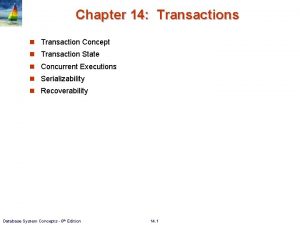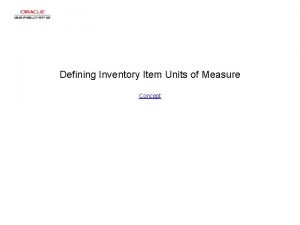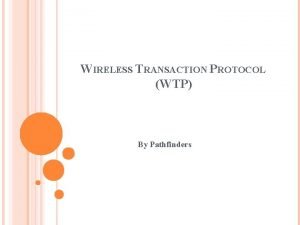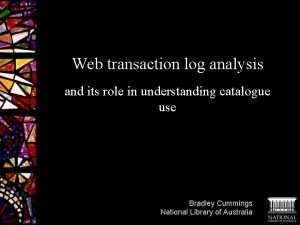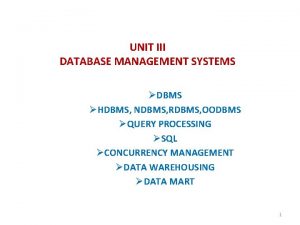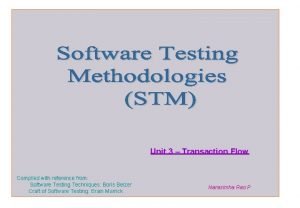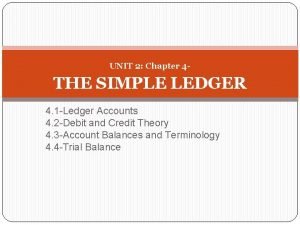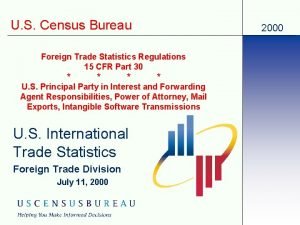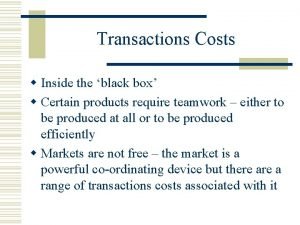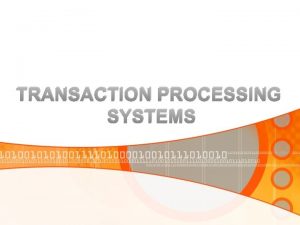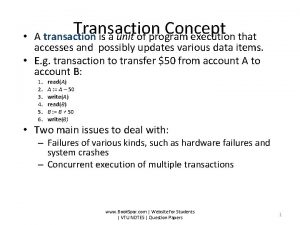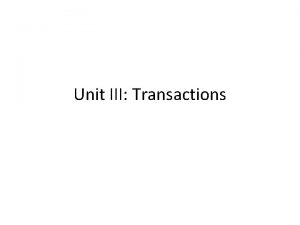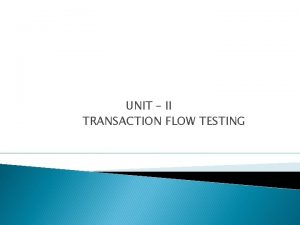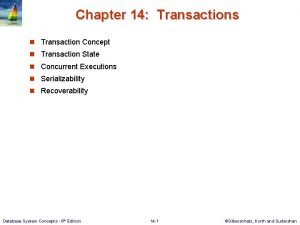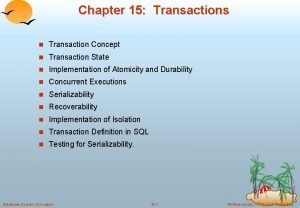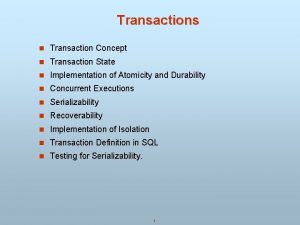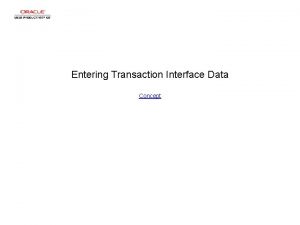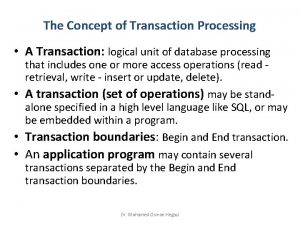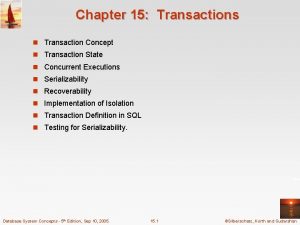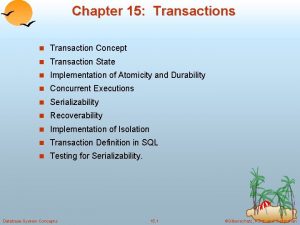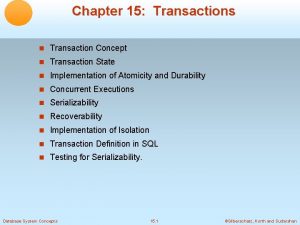Transaction Concept n A transaction is a unit
























- Slides: 24

Transaction Concept n A transaction is a unit of program execution that accesses and possibly updates various data items. n E. g. transaction to transfer $50 from account A to account B: 1. read(A) 2. A : = A – 50 3. write(A) 4. read(B) 5. B : = B + 50 6. write(B) n Two main issues to deal with: l Failures of various kinds, such as hardware failures and system crashes l Concurrent execution of multiple transactions 15. 1

Example of Fund Transfer n Transaction to transfer $50 from account A to account B: 1. read(A) 2. A : = A – 50 3. write(A) 4. read(B) 5. B : = B + 50 6. write(B) n Atomicity requirement l if the transaction fails after step 3 and before step 6, money will be “lost” leading to an inconsistent database state 4 l n Failure could be due to software or hardware the system should ensure that updates of a partially executed transaction are not reflected in the database Durability requirement — once the user has been notified that the transaction has completed (i. e. , the transfer of the $50 has taken place), the updates to the database by the transaction must persist even if there are software or hardware failures. 15. 2

Example of Fund Transfer (Cont. ) n Transaction to transfer $50 from account A to account B: 1. 2. 3. 4. 5. 6. read(A) A : = A – 50 write(A) read(B) B : = B + 50 write(B) Consistency requirement in above example: l the sum of A and B is unchanged by the execution of the transaction n In general, consistency requirements include 4 Explicitly specified integrity constraints such as primary keys and foreign keys 4 Implicit integrity constraints – e. g. sum of balances of all accounts, minus sum of loan amounts must equal value of cash-in-hand l A transaction must see a consistent database. l During transaction execution the database may be temporarily inconsistent. l When the transaction completes successfully the database must be consistent 4 Erroneous transaction logic can lead to inconsistency n 15. 3

Example of Fund Transfer (Cont. ) n Isolation requirement — if between steps 3 and 6, another transaction T 2 is allowed to access the partially updated database, it will see an inconsistent database (the sum A + B will be less than it should be). T 1 T 2 1. read(A) 2. A : = A – 50 3. write(A) read(A), read(B), print(A+B) 4. read(B) 5. B : = B + 50 6. write(B n Isolation can be ensured trivially by running transactions serially that is, one after the other. n However, executing multiple transactions concurrently has significant benefits, as we will see later. l 15. 4

ACID Properties A transaction is a unit of program execution that accesses and possibly updates various data items. To preserve the integrity of data the database system must ensure: n Atomicity. Either all operations of the transaction are properly reflected in the database or none are. n Consistency. Execution of a transaction in isolation preserves the consistency of the database. n Isolation. Although multiple transactions may execute concurrently, each transaction must be unaware of other concurrently executing transactions. Intermediate transaction results must be hidden from other concurrently executed transactions. l That is, for every pair of transactions Ti and Tj, it appears to Ti that either Tj, finished execution before Ti started, or Tj started execution after Ti finished. n Durability. After a transaction completes successfully, the changes it has made to the database persist, even if there are system failures. 15. 5

Transaction State 15. 6

Transaction State n Active – the initial state; the transaction stays in this state while it is executing n Partially committed – after the final statement has been executed. n Failed -- after the discovery that normal execution can no longer proceed. n Aborted – after the transaction has been rolled back and the database restored to its state prior to the start of the transaction. Two options after it has been aborted: l restart the transaction 4 l can be done only if no internal logical error kill the transaction n Committed – after successful completion. 15. 7

Concurrent Executions n Multiple transactions are allowed to run concurrently in the system. Advantages are: l increased processor and disk utilization, leading to better transaction throughput 4 E. g. one transaction can be using the CPU while another is reading from or writing to the disk l reduced average response time for transactions: short transactions need not wait behind long ones. n Concurrency control schemes – mechanisms to achieve isolation l that is, to control the interaction among the concurrent transactions in order to prevent them from destroying the consistency of the database 15. 8

Schedules n Schedule – a sequences of instructions that specify the chronological order in which instructions of concurrent transactions are executed l a schedule for a set of transactions must consist of all instructions of those transactions l must preserve the order in which the instructions appear in each individual transaction. n A transaction that successfully completes its execution will have a commit instructions as the last statement l by default transaction assumed to execute commit instruction as its last step n A transaction that fails to successfully complete its execution will have an abort instruction as the last statement 15. 9

Schedule 1 n Let T 1 transfer $50 from A to B, and T 2 transfer 10% of the balance from A to B. n A serial schedule in which T 1 is followed by T 2 : 15. 10 A=$1000 B=$2000

Schedule 2 • A serial schedule where T 2 is followed by T 1 15. 11 A=$1000 B=$2000

Schedule 3 n Let T 1 and T 2 be the transactions defined previously. The following schedule is not a serial schedule, but it is equivalent to Schedule 1. A=$1000 B=$2000 In Schedules 1, 2 and 3, the sum A + B is preserved. 15. 12

Schedule 4 n The following concurrent schedule does not preserve the value of (A + B ). A=$1000 B=$2000 15. 13

Serializability n Basic Assumption – Each transaction preserves database consistency. n Thus serial execution of a set of transactions preserves database consistency. n A (possibly concurrent) schedule is serializable if it is equivalent to a serial schedule. Different forms of schedule equivalence give rise to the notions of: 1. conflict serializability 2. view serializability n Simplified view of transactions l We ignore operations other than read and write instructions l We assume that transactions may perform arbitrary computations on data in local buffers in between reads and writes. l Our simplified schedules consist of only read and write instructions. 15. 14

Conflicting Instructions n Instructions li and lj of transactions Ti and Tj respectively, conflict if and only if there exists some item Q accessed by both li and lj, and at least one of these instructions wrote Q. 1. li = read(Q), lj = read(Q). 2. li = read(Q), lj = write(Q). 3. li = write(Q), lj = read(Q). 4. li = write(Q), lj = write(Q). li and lj don’t conflict. They conflict n Intuitively, a conflict between li and lj forces a (logical) temporal order between them. l If li and lj are consecutive in a schedule and they do not conflict, their results would remain the same even if they had been interchanged in the schedule. 15. 15

Conflict Serializability n If a schedule S can be transformed into a schedule S´ by a series of swaps of non-conflicting instructions, we say that S and S´ are conflict equivalent. n We say that a schedule S is conflict serializable if it is conflict equivalent to a serial schedule 15. 16

Conflict Serializability (Cont. ) n Schedule 3 can be transformed into Schedule 6, a serial schedule where T 2 follows T 1, by series of swaps of nonconflicting instructions. l Therefore Schedule 3 is conflict serializable. Schedule 6 Schedule 3 15. 17

Recoverable Schedules Need to address the effect of transaction failures on concurrently running transactions. n Recoverable schedule — if a transaction Tj reads a data item previously written by a transaction Ti , then the commit operation of Ti appears before the commit operation of Tj. n The following schedule (Schedule 11) is not recoverable if T 9 commits immediately after the read n If T 8 should abort, T 9 would have read (and possibly shown to the user) an inconsistent database state. Hence, database must ensure that schedules are recoverable. 15. 18

Cascading Rollbacks n Cascading rollback – a single transaction failure leads to a series of transaction rollbacks. Consider the following schedule where none of the transactions has yet committed (so the schedule is recoverable) If T 10 fails, T 11 and T 12 must also be rolled back. n Can lead to the undoing of a significant amount of work 15. 19

Cascadeless Schedules n Cascadeless schedules — cascading rollbacks cannot occur; for each pair of transactions Ti and Tj such that Tj reads a data item previously written by Ti, the commit operation of Ti appears before the read operation of Tj. n Every cascadeless schedule is also recoverable n It is desirable to restrict the schedules to those that are cascadeless 15. 20

Concurrency Control n A database must provide a mechanism that will ensure that all possible schedules are l either conflict or view serializable, and l are recoverable and preferably cascadeless n A policy in which only one transaction can execute at a time generates serial schedules, but provides a poor degree of concurrency l Are serial schedules recoverable/cascadeless? n Testing a schedule for serializability after it has executed is a little too late! n Goal – to develop concurrency control protocols that will assure serializability. 15. 21

Levels of Consistency in SQL-92 n Serializable — default n Repeatable read — only committed records to be read, repeated reads of same record must return same value. However, a transaction may not be serializable – it may find some records inserted by a transaction but not find others. n Read committed — only committed records can be read, but successive reads of record may return different (but committed) values. n Read uncommitted — even uncommitted records may be read. n Lower degrees of consistency useful for gathering approximate information about the database n Warning: some database systems do not ensure serializable schedules by default l E. g. Oracle and Postgre. SQL by default support a level of consistency called snapshot isolation (not part of the SQL standard) 15. 22

Transaction Definition in SQL n Data manipulation language must include a construct for specifying the set of actions that comprise a transaction. n In SQL, a transaction begins implicitly. n A transaction in SQL ends by: l Commit work commits current transaction and begins a new one. l Rollback work causes current transaction to abort. n In almost all database systems, by default, every SQL statement also commits implicitly if it executes successfully l Implicit commit can be turned off by a database directive 4 E. g. in JDBC, connection. set. Auto. Commit(false); 15. 23

Implementation of Isolation n Schedules must be conflict (or view) serializable, and recoverable, for the sake of database consistency, and preferably cascadeless. n A policy in which only one transaction can execute at a time generates serial schedules, but provides a poor degree of concurrency. n Concurrency-control schemes tradeoff between the amount of concurrency they allow and the amount of overhead that they incur. n Some schemes allow only conflict-serializable schedules to be generated, while others allow view-serializable schedules that are not conflict-serializable. 15. 24
 Precedence graph
Precedence graph Transaction concept
Transaction concept Unit 6 review questions
Unit 6 review questions Compare real self and ideal self
Compare real self and ideal self Perbedaan selling concept dan marketing concept
Perbedaan selling concept dan marketing concept Concept of intensive care unit
Concept of intensive care unit Materials handling design
Materials handling design Unit of measure concept
Unit of measure concept Metode pembiayaan semi langsung
Metode pembiayaan semi langsung Right triangle trigonometry examples
Right triangle trigonometry examples English unit conversions
English unit conversions Unit 1 test algebra 2 answers
Unit 1 test algebra 2 answers Perhitungan unit cost rekam medis
Perhitungan unit cost rekam medis Unit process and unit operation
Unit process and unit operation What is unit operation and unit process
What is unit operation and unit process Setiap unit akuntansi dianggap sebagai unit yang mandiri
Setiap unit akuntansi dianggap sebagai unit yang mandiri Explain the classes of wtp
Explain the classes of wtp Transaction log analysis
Transaction log analysis Ndbms
Ndbms Transaction flow graph
Transaction flow graph Chapter 4 the simple ledger answers
Chapter 4 the simple ledger answers Foreign trade statistics regulations
Foreign trade statistics regulations Types of information system
Types of information system Market transaction example
Market transaction example Characteristics of tps
Characteristics of tps

